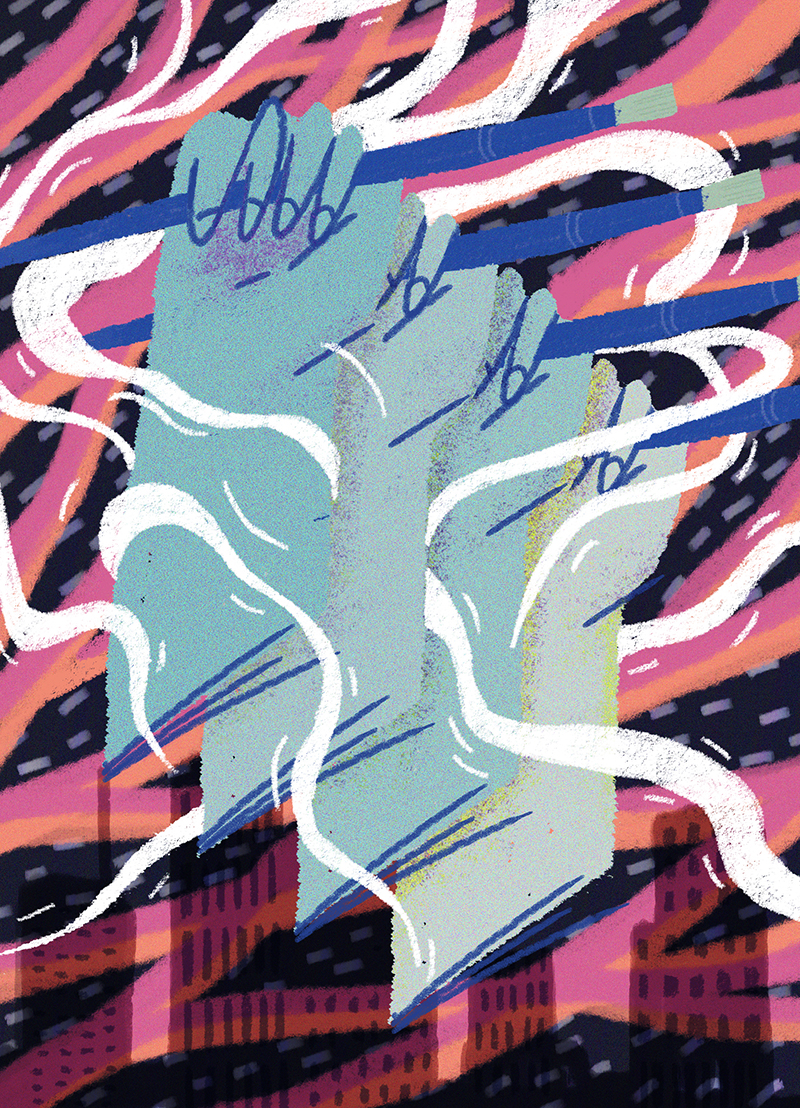
Leaving your artistic mark on a community
History of Art & Visual Culture Assistant Professor Liz Trapp caught up with two CCAD alumni working in Columbus about art and its impact on the city.
The key to starting a successful arts space depends on more than just stating your mission. It means clearly defining how you will accomplish it — and stay true to it.

Illustration by Alma Kim (Animation, 2019) for CCAD Student Agency
To choose a career in the fine arts is, to many graduates of Columbus College of Art & Design, to choose to make a difference in the world around them — to challenge the norm, to change viewpoints, to start a new conversation.
CCAD alumni have a long-held tradition of exploring a problem and working to change it. In Columbus, reshaping culture and commerce happens in myriad ways because of the city’s smart, open community that allows artists to leave their mark.
Here you’ll find a number of influential arts spaces run by CCAD alumni, including Corrugate, Skylab Gallery, and The Vanderelli Room. While the art styles these venues represent can vary, one thing remains the same for all DIY spaces: navigating the politics of the arts world.
At some point or another, all artists — and those working to lift up messages of change — face the same challenge: Is it better to work within existing structures or create your own?
The answer depends on what you want to accomplish.
Take, for example, No Place Gallery, a combination gallery and studio space run by James McDevitt-Stredney (Fine Arts, 2012). No Place Gallery is so named for its nondescript location. It plays on its own terms, bringing cutting-edge conceptual and international art here to empower the city’s art evolution.
As an example, No Place Gallery recently showed work by a group of local and international artists of color during the inaugural exhibition of The Black Infinity, a collective founded by another CCAD alumnus and current visiting faculty, Tosha Stimage (Fine Arts, 2011). Complementing the exhibition was a succession of community outreach events — from a panel of local arts leaders (hosted by three current CCAD fine arts students), to skillshare workshops, and a body positive session.
While No Place Gallery aims to make the city part of a larger international discussion, Wild Goose Creative, in contrast, uses daily and nightly programming to enhance the Columbus community by way of the community itself. This nonprofit arts organization balances objectives of building up the community and promoting the arts by focusing on the voices behind each.
“We aren’t in the business of deciding who has the best art and why,” says Heather Lynn Kyle (Fine Arts, Art History, 2008), president of the board of directors at Wild Goose Creative. “We aim to lift up people who have artistic voices waiting to be heard.”
Wild Goose Creative, an all-purpose space, operates as a gallery but also lends its venue to creative types of all stripes, hosting comedy shows, fundraising dance parties, intimate local concerts, and much more. The shifting role of this space exemplifies the dynamic nature of Wild Goose. This flexibility is how it accomplishes its goals.
Kyle emphasizes the space’s focus on education and community programming and how this caters to Columbus’ close-knit community of artists and art lovers. The focus on education is what has kept Wild Goose Creative relevant in a constantly shifting community, one where more and more artists are focused on political and social issues. Consider their 2018 programming schedule. It includes a woman’s mentorship program called She Creates, and Human School, a series of educational discussions.
Both Wild Goose Creative and No Place Gallery tirelessly seek different avenues to serve their community — large or small. From both, we see examples of how to work within an already established structure of an arts organization.
If you choose to work within a structure, develop its boundaries yourself and stay true to that. Do your homework. Know your mission and let that guide you. Look at the landscape you’re working within, observe how it shifts, changes, transforms, and respond.
And always this: Work tirelessly. Work passionately.
Liz Trapp is assistant professor of History of Art & Visual Culture. She teaches a variety of courses from survey art history to art history thesis in addition to collaborating with the department of Fine Arts in integrated studio and history courses.
Post date
March 9, 2018